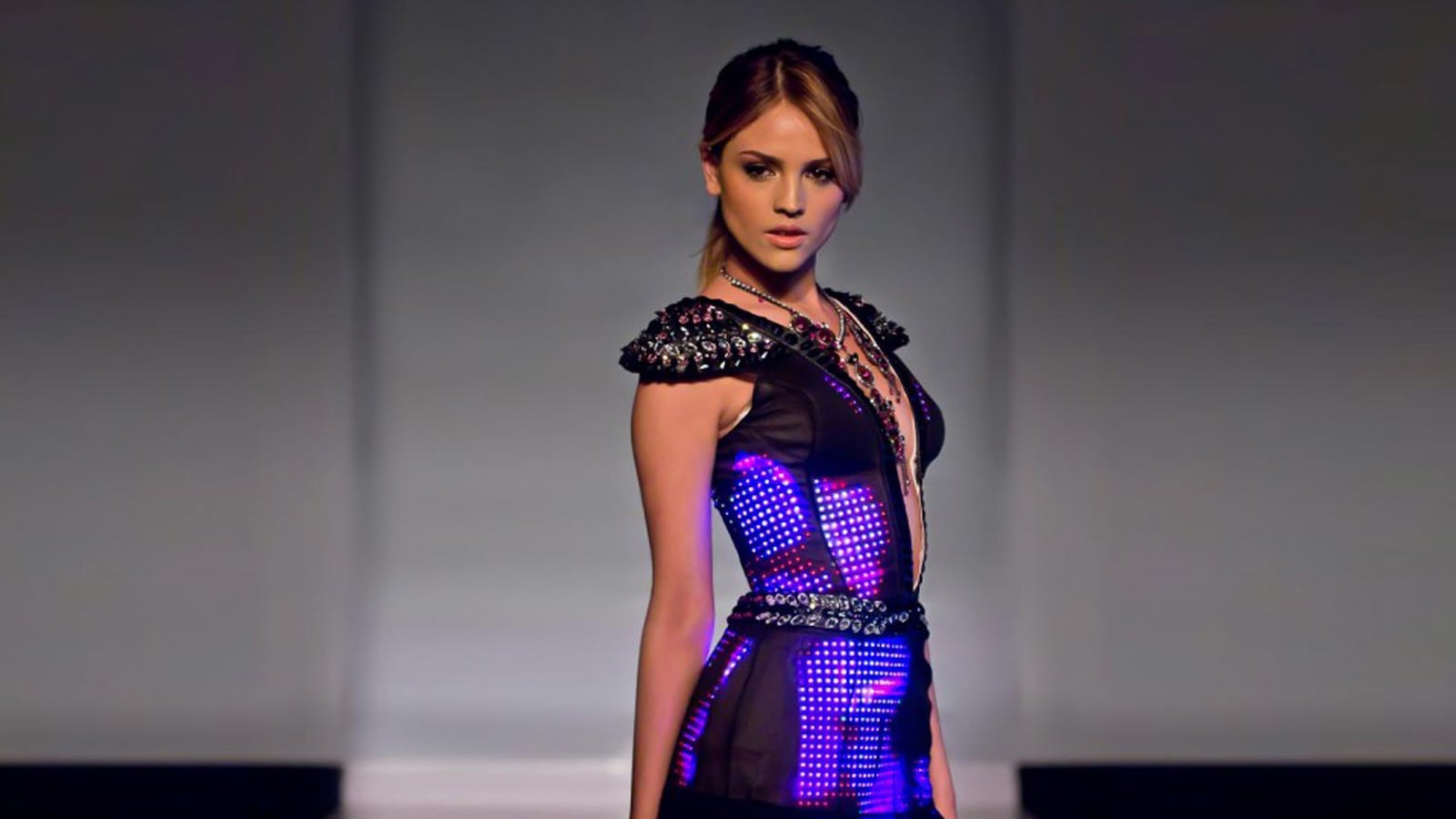The biggest trend in fashion this year? Transparency. No, we’re not talking about see-through garments—though judging from the red carpet, those were in vogue too. We’re talking about fashion designers and manufacturers using technology in innovative ways to create more informed consumers, from embedding chips in a sweater to tell you the living conditions of the sheep who provided the wool to creating apps that aggregate the environmental impact of every material imaginable. And that’s just the start. Indeed, 2014’s technological breakthroughs weren’t the Apple watch or some other wearable, but stuff designed to actually make our planet greener, our bodies healthier, and our wallets lighter. From truly cruelty-free leather to bio-textiles you can wear in outer space, here are the craziest, most exciting, and life-changing fashion innovations of the year.
Wearables Get, Well, Wearable

The problem with most wearables? They’re rarely things you’d actually want to wear. (Have you seen Google Glass?) Fortunately, designers have taken matters into their own hands, creating cool studded bracelets that double as phone chargers and delicate necklaces that let you know when you get an email or text. The most promising in this new category of tech-infused accessories is Ringly, a chic 18k-gold cocktail ring that subtly vibrates when you get a phone call or calendar alert (so you’ll never be late to a meeting again). “Designers are realizing that they don’t have to create the Swiss army knife of fashion when it comes to wearables,” “fashion technologist” Amanda Parkes says. “It offers the right amount of info on the right part of the body.”
Cruelty-free Leather

In 2013, it was all about the lab-grown burger. Now, it’s lab-grown leather that’s in vogue. Brooklyn-based company Modern Meadow raised more than $10 million in Series A funding this year to create cruelty-free skins from a tissue-engineering technique called “biofabrication.” The process would produce a material that mimics the properties of leather more convincingly than the vegan, synthetic options currently on the market. And, it could allow designers to keep up with the demand on goods such as motorcycle jackets, over-the-knee boots, and handbags without the environmental—and moral—hazards of leather production. (Can they work on creating you’ll-never-believe-it’s-faux fur next?)
The New and Improved 3D-printed Dress

Designers have been experimenting with 3D-printed materials for several years now, but couture laboratory Nervous System has actually created a process through which you can print a dress and wear it straight out of the machine. It also, unlike other 3D-printed garments, moves like fabric, thanks to the 3,316 hinges that link its 2,279 interlocking triangular panels. The dress was so impressive that it—and the technology used to create it—is now part of MoMA’s permanent design collection.
Stilettos You Can Actually Walk In
The high heel has gone through endless aesthetic changes throughout the years. But, its structural engineering hasn’t been addressed in 100 years, despite the fact that stilettos damage your feet, are bad for your health, and hurt like hell. Enter Thesis Couture, a women-helmed company that aims to rethink the stiletto from the inside out lead by a design team that includes three scientists, an astronaut, fabricators, artisans and a surgeon. Though not in production yet, the high-end heels will be sold through a Tesla-like model. “Initially they’ll be very expensive to cover the whole process,” says Parkes, who is one of the co-founders, “till the technology starts to trickle down into a more reasonable price point.”
Bio Chic
Is biology the new black? 2014 saw designers going into the lab to concoct all sorts of weird bio-textile experiments, from regenerating, self-repairing running shoes made of protocells—imagined by London-based Alexander McQueen alum Shamees Aden—to 3D-printed “wearable skins” embedded with micro-habitats or systems that would allow its wearer to survive on different planets, a project of MIT’s Media Lab. Yeah, they look like they’re right out of a sci-fi movie, but in a haute couture, instead of Star Trek, sort of way. And, hey, they would make life on Mars even cooler.
Clothes That Tell You Where They Came From
OK, forget biology, says the Fashion Institute of Technology’s Ingrid Johnson: “Transparency is the new black…Young people particularly want to know everything about a product, from how much it can affect the environment to why it costs what it does.” A few brands have embedded chips or barcodes into their clothing tags, which the customer can scan in order to find out everything about a garment, from the wages of the workers who sewed it to how much it’s been marked up. Our favorite of these: Icebreaker’s Baacode, which will tell you—among other things—the living conditions of the sheep sheared for your sweater.
An App That Helps Designers Choose Green Materials
Nike has been at the forefront of cutting-edge materials technology, but its latest project establishes it as a leader in sustainable, ecological design, too. Studying the environmental impact of different materials—from their greenhouse effect to water usage and residual waste—Nike has compiled eight years worth of its findings into one handy app for apparel and footwear designers, called Making, which empowers brands to make more informed design decisions. The latest version, which came out this year, includes information on a range of materials, including commonplace cotton to EVA foam, as well as other features like comparison tools and tips for lowering your carbon footprint.
The Endlessly Customizable Dress
At New York Fashion Week this spring, designers CuteCircuit debuted a dress that can change color and pattern through an app that the wearer controls herself. The technology is not just cool, it actually makes the idea of transitioning from day to night easier, eliminates the need for so many items of clothing, and (with that elimination of waste) is actually good for the environment, too.
Washable, Stink-free Sneakers
Running shoes that you can wear without socks and that won’t smell? Yes, they exist, and they weren’t created in a lab, either. Turns out that wool regulates temperature, repels water, wicks away moisture, and resists stains and dirt. So, when looking to create a new running shoe they could wear without socks, the brothers behind New Zealand start-up Three Over Seven reached out to textile experts at AgResearch to create a super-durable wool that you could wear on your feet. The resulting Wool Runners were comfortable, eco-friendly, machine-washable, and super cute—and sold out almost immediately. Not to worry, more are on the way.
A Jacket That Repels Germs

Listen up, commuters—your public transit rides are about to get a lot less gross! Innovation firm gravitytank has teamed up with fashion company Betabrand to create a jacket that helps fend off germs from sneezing subway users (and worse). The Germinator looks like a regular waterproof jacket but includes silver-infused, anti-microbrial fabric on the sleeves and collar, filtering out unpleasant smells and keeping you so fresh and so clean on your journey home. An obsessive-compulsive’s dream garment.





